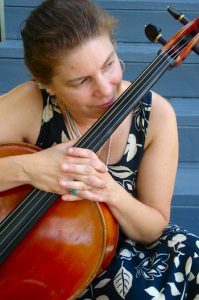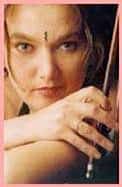By Sera Smolen
 Saskia Rao de Haas
Saskia Rao de Haas
Saskia Rao de Haas introduces a new sound in the world of Indian classical music. A brilliant cellist from the Netherlands, she has modified the cello to perform north Indian classical music. With a strong foundation in western classical and Indian classical music, and no precedent to follow, Saskia has worked with singular dedication to adapt the cello to Indian classical music. Her playing style enables her to bring out both the subtleties and embellishments characteristic of north Indian classical music. She has incorporated new techniques that allow her to nurture the inherent closeness of the cello to the human voice and further explore the brilliance of her instrument.
Saskia is based in Delhi with her husband Shubhendra Rao, well-known sitarist of the Maihar gharana. They compose and play together pieces that are based purely on Indian classical ragas as well as compositions in which their different musical backgrounds are explored.
Sera Smolen: You were trained in Holland, yet you now play Indian music exclusively on your cello. How did the shift occur?
Saskia RdH: It was gradual. I began listening to Indian music in musicology class, so I became intrigued, listening more and more. Eventually I learned that there is a department in Rotterdam, which is the first conservatory in the west to have a classical Indian music department, and I enrolled.
 SS: What was your training like in Rotterdam?
SS: What was your training like in Rotterdam?
SaskiaRdH: I became completely different, as if I was a child again with music. In Indian music, there is no vibrato, very very fine intonation, and lots of emphasis on the way you move from note to note. The notes have an exact point, but the real art of Indian musician utilizes every nuance of pitch in between the notes. All of this happens in relation to the tamboura (a droning instrument).
The handling of the bow is very different as well. There is less tension on the bow hair. You could say it is a little like in baroque music, where the expressive intensity, the shaping of long notes, happens mostly in the middle or the end of the note.
The difficulties you encounter in mastering Indian music are different than in western classical music. Aural memory needs to be trained extensively. Lessons are all about imitating the teacher. By “doing” the teacher’s improvisation, one gradually learns to do one’s own improvisation. There are so many things that cannot be written down. We got very far away from written music in my training, communicating about music through feeling instead.
In Amsterdam I did both kinds of cello playing. Gradually western became less and less, Indian became more and more.
SS: As you became more identified with Indian music, how did your musicianship continue to change?
SaskiaRdH: Rags (scales) and Talas (rhythms) create an entirely different musical grammar. I was given the Bhairav rag to learn. There are rags for the morning, the afternoon, the evening, etc., so Bhairav is a rag for the morning. I spent eight months playing and learning nothing but Bhairav! This is not uncommon, and was very helpful to me. With each rag, you tune yourself to IT. I discovered, as I tuned myself to the nature of the rag, to the essence of Bhairav, the pitches became very exact and precise. I realized that the notes were absolute, even eternal, because Bhairav is a part of the natural universe. You find these notes are more than tempered. An Indian musician will tune the ga (the third) of a rag lower or higher, depending on the inner logic of the particular rag being played, because that really is an absolute note.
The rhythmic education taught, particularly in South India, is so comprehensive that I cannot imagine one aspect of rhythmic training that is overlooked. Rhythm is not only played, but also spoken, and exercises are given beginning in childhood. For example, they keep the beat going no matter what, counting to 9, 11, 14, and anything can go against it.
Practicing is a real joy. We do not practice to train for what we will do on stage. Practicing is exercises, and is about going “into” each note, and into the world of each rag. It is about the musical journey, not the destination. It is fun to experiment and play with one rag for hours and hours. Then you go out on stage and do just what you do when you practice.
SS: You began this journey with the instrument you used in your classical training, but now your cello is different. I saw fifteen tuning pegs in the peg box of this instrument when I heard you play last spring. What inspired you to make changes to the instrument itself?
SaskiaRdH: Now, I am playing the third cello custom made for me. First, needing resonating strings for my cello, I went to my luthier in Holland, Eduard van Tongeren. He started by putting resonating strings on the belly of the instrument, under the fingerboard, which I tuned to the notes of the rag we were playing. The actual strings I bowed on that first cello were tuned to: C=C#; G=G#, D=C#, A=G#.
The next cello was a children’s 1/2 size cello, again with resonating strings added to it, this time from the bridge to the bottom of the neck. I tuned this instrument up one octave, and found that this sound was still not quite the sound I wanted. The third one, the instrument I play on now, is incredibly dynamic. Eduard van Tongeren was willing to make me an instrument that has a blend of Indian and European attributes.
Creating, or recreating an instrument tailored to my needs was like studying the past in order to reinvent the future. Fortunately, contemporary instrument makers are interested in baroque instrument construction. There are many bowed instruments in India, and there are many ways and many places to connect and attach strings. The body of this third instrument is from a German half size cello. The neck is like a viola d’amore. The bridge for the resonating strings is a bone bridge, which is found on certain Indian instruments. This gives the instrument “jivari” (“soul” in the sound). Five bowed strings are tuned to DADAD, and ten resonating strings are tuned to the notes of the rag. The ten resonating strings are attached this time so they go up through the neck, and are tuned from the peg box.
In the alap (an a-metrical improvised exposition of a raga) there is, traditionally, a gradual build up, first introducing the notes of the rag in the lower octave, slowly working from there to the higher octaves. In general, low and high, the cello has a very close resemblance to the human voice. The fast sargams (phrases) on the high D string above the A string make the cello sound like it’s Indian sister instrument, the sarangi.
I sit on the floor, with crossed legs, and the cello now is the perfect size. I sit on a shawl, and there is a hole in the other end of the shawl for the cello, since it doesn’t have an endpin.
SS: What is important about having resonating strings?
SaskiaRdH: Indian Classical music tunes the resonating strings to the notes of each rag you are using, so they resonate to the absolute pitches of the rag as you play. The musician is to resonate “in” the absolute pitches of each rag. This very fine-tuning of the instrument fine-tunes you and your mentality over time.
There are different aesthetic priorities in Indian music. In western culture, it is honorable, and desirable to be an important person. In the west, it is even better to be a celebrity. However, in India, people know they are just a small part of a very big picture. The resonating strings combined with the deep concentration necessary to improvise place you inside an eternal vibration. In Indian music, the Nada Brahman, this eternal vibration, is the big picture. The beauty of all music occurs then in the fine nuances, the elaborations and details that play within the Nada Brahman. Whenever I feel that reality even for a fraction of a second on stage or just playing at home, I know why I chose this music.
* * * * *
